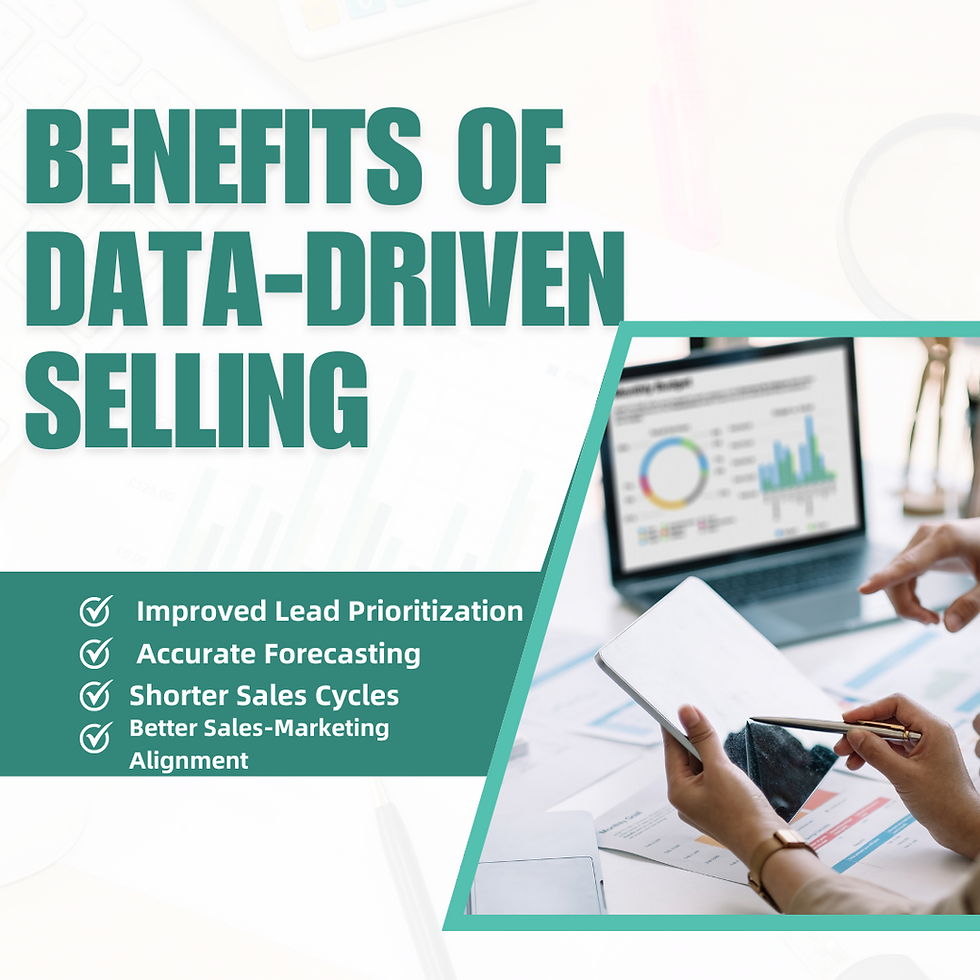Data-Driven Selling Is Not a Buzzword; It's a Requirement
- ClickInsights

- Aug 21
- 3 min read
Introduction
Imagine your sales reps are very skilled, your product is solid, but forecasts often fail to meet their marks. Promising deals do not close, and managers are left scratching their heads, wondering why. The solution usually is not effort, but process. Too many organizations continue to view data-driven selling as a nice-to-have or a buzzword, but not as a vital business practice.
Shoppers today are better informed than ever. They surf the web for product information, compare prices, and demand one-on-one interaction before even talking to a sales representative. Gut feelings and old-style salesmanship no longer suffice. Businesses that don't adopt a data-first strategy risk losing opportunities, wasting investments, and unpredictable revenues.
In this blog, we will see why data-driven selling is crucial for businesses today, the quantifiable advantages it provides, misconceptions, and actionable steps leaders can use to transition to an analytical, insight-based sales model. By incorporating data throughout all phases of your sales process, you can turn uncertainty into predictable growth.

What is Data-Driven Selling
Data-driven selling is the act of employing analytics, customer behavior insights, and predictive software to make decisions throughout the sales process. Unlike historical techniques, which are usually based on instinct, experience, or anecdotal proof, data-driven selling gives objective signs to direct every move, from prospecting through closing.
The value of this method has increased in the competitive environment of today. Purchasers are highly informed before even talking to your salespeople. Briefer sales cycles and more than enough competition leave gut-based decisions more at risk than ever. Leveraging data enables your salespeople to make decisions strategically, focus on what matters most, and make more predictable and effective choices.
The Benefits of Data-Driven Selling
1. Improved Lead Prioritization
Not every lead is equal. By analyzing engagement levels and applying predictive lead scoring, data-driven sales teams pinpoint high-conversion prospects. Prioritizing high-intent buyers, teams decrease wasted effort and improve conversion rates. Research indicates firms leveraging predictive analytics can experience as much as a 30% rise in lead-to-opportunity conversion.
2. Accurate Forecasting
Gut feeling forecasts are unreliable by nature. Data-driven methods utilize historical performance, pipeline analysis, and predictive models to offer more reliable sales forecasts. Leadership is able to allocate better resources, plan headcount, and make business decisions with the assurance that more reliable forecasts are available.
3. Shorter Sales Cycles
Teams are able to immediately spot high-priority leads and eliminate bottlenecks in the sales process by examining buyer behavior and engagement patterns. Deal closure accelerates, as well as revenue velocity.
4. Better Coaching and Performance Management
Objective insights from data enable managers to deliver targeted coaching based on hard facts instead of personal impressions. Conversation intelligence software, for instance, can expose which communication patterns close deals, and enable reps to copy top-performer behaviors.
5. Better Sales-Marketing Alignment
Sharing information between sales and marketing teams maintains consistent messaging and integrated campaigns. When both teams work from the same information, prospects have a smooth buyer experience, trust is fostered, and conversion rates are better.
Misconceptions About Data-Driven Selling
It replaces sales reps. actually, it enables reps to work more intelligently, not harder.
It is strictly for big businesses. Small groups can reap the benefits of analytics in decision-making with little investment.
A CRM is sufficient: Gathering data is one aspect; translating it into actionable information is what brings results.
Clarifying and eliminating these myths enables organizations to implement data-driven selling successfully and sidesteps the failures of halfway measures.
How to Begin Implementing Data-Driven Selling
Audit your existing processes: Look for places where intuition is making the decisions.
Invest in the right tools: Today's CRM platforms, sales intelligence solutions, and conversation analytics are required.
Educate your team: Ensure reps can interpret data and act on the insights it provides.
Begin with a pilot: Apply predictive lead scoring or pipeline analytics to a single team segment before expanding across the organization.
Monitor, measure, and iterate: Refine processes continuously based on real-world outcomes and feedback.
By adopting these steps, organizations can bring about a gradual transition to a data-driven decision-making culture with minimal disruption to current operations.
Conclusion
Data-driven selling is not a nice-to-have trend anymore; it's a must-have for measurable revenue, increased win rates, and effective resource management. In a world where buyers are educated, decisions need to be made quickly, and competition is high, relying on intuition only puts organizations at a big disadvantage.
Today's sales success is not about shoving products or predicting results. It is about leading educated buyers, with objective, fact-based insights, and making every action measurable and accountable. Leaders who bring data into the sales process build a repeatable, scalable model that turns uncertainty into actionable insight.
Begin today by examining your current procedures, determining areas controlled by intuition, and practicing data-based methods gradually. Done properly, data-driven selling converts guesswork into certainty and opportunities into steady revenue growth.



What I love about Escape Road is the instant play – no download, just pure reflex fun in your browser. https://escaperoadx.com